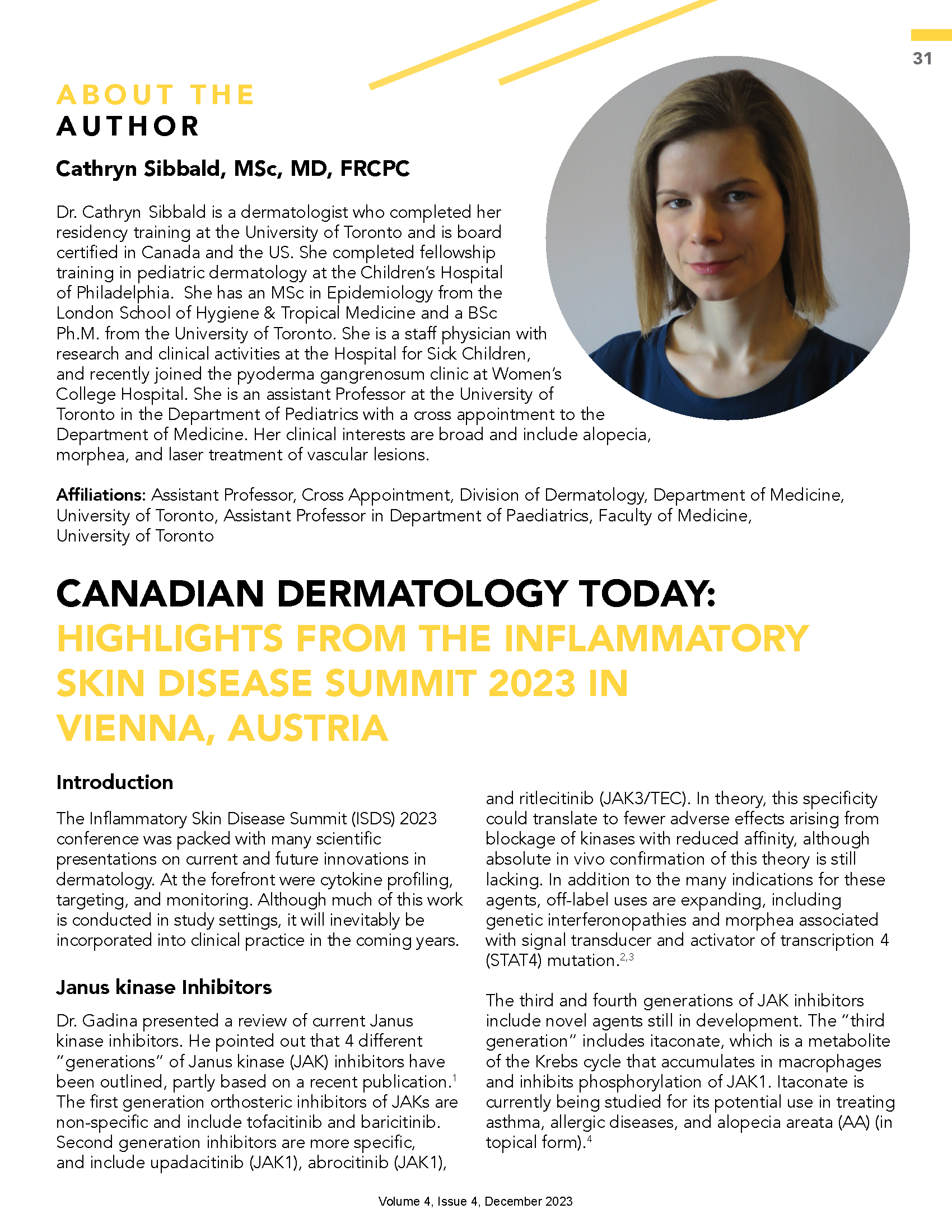Highlights from the Inflammatory Skin Disease Summit 2023 in Vienna, Austria
Abstract
The Inflammatory Skin Disease Summit (ISDS) 2023 conference was packed with many scientific presentations on current and future innovations in dermatology. At the forefront were cytokine profiling, targeting, and monitoring. Although much of this work is conducted in study settings, it will inevitably be incorporated into clinical practice in the coming years.
References
Bonelli M, Kerschbaumer A, Kastrati K, Ghoreschi K, Gadina M, Heinz LX, et al. Selectivity, efficacy and safety of JAKinibs: new evidence for a still evolving story. Ann Rheum Dis. 2023. doi:10.1136/ard-2023-223850
Baghdassarian H, Blackstone SA, Clay OS, Philips R, Matthiasardottir B, Nehrebecky M, et al. Variant STAT4 and response to ruxolitinib in an autoinflammatory syndrome. N Engl J Med. 2023;388(24):2241-2252. doi:10.1056/NEJMoa2202318
Li W, Wang W, Wang W, Zhong L, Gou L, Wang C, et al. Janus Kinase Inhibitors in the Treatment of type i interferonopathies: A Case Series From a Single Center in China. Front Immunol. 2022;13:825367. doi:10.3389/fimmu.2022.825367
Tsai J, Gori S, Alt J, Tiwari S, Iyer J, Talwar R, et al. Topical SCD-153, a 4-methyl itaconate prodrug, for the treatment of alopecia areata. PNAS Nexus. 2023;2(1):pgac297. doi:10.1093/pnasnexus/pgac297
Tang Q, Fakih HH, Zain Ui Abideen M, Hildebrand SR, Afshari K, Gross KY, et al. Rational design of a JAK1-selective siRNA inhibitor for the modulation of autoimmunity in the skin. Nat Commun. 2023;14(1):7099. doi:10.1038/s41467-023-42714-4
Bertolini M, McElwee K, Gilhar A, Bulfone-Paus S, Paus R. Hair follicle immune privilege and its collapse in alopecia areata. Exp Dermatol. 2020;29(8):703-725. doi:10.1111/exd.14155
Suzuki T, Scala F, Demetrius DL, Gherardini J, Rodriguez-Feliz J, Kuka-Epstein G, et al. IL-15 prolongs anagen, stimulates proliferation, and suppresses apoptosis in the hair matrix of human scalp hair follicles. J Invest Dermatol. 2023. doi:10.1016/j.jid.2023.06.206
King B, Zhang X, Harcha WG, Szepietowski JC, Shapiro J, Lynde C, et al. Efficacy and safety of ritlecitinib in adults and adolescents with alopecia areata: a randomised, double-blind, multicentre, phase 2b-3 trial. Lancet. 2023;401(10387):1518-1529. doi:10.1016/S0140-6736(23)00222-2
Guttman-Yassky E, Pavel AB, Diaz A, Zhang N, Del Duca E, Estrada Y, et al. Ritlecitinib and brepocitinib demonstrate significant improvement in scalp alopecia areata biomarkers. J Allergy Clin Immunol. 2022;149(4):1318-1328. doi:10.1016/j.jaci.2021.10.036
Traidl S, Harries L, Kienlin P, Begemann G, Roesner LM, Werfel T. Dupilumab strengthens herpes simplex virus type 1-specific immune responses in atopic dermatitis. J Allergy Clin Immunol. 2023. doi:10.1016/j.jaci.2023.08.024
Glickman JW, Dubin C, Renert-Yuval Y, Dahabreh D, Kimmel GW, Auyeung K, et al. Cross-sectional study of blood biomarkers of patients with moderate to severe alopecia areata reveals systemic immune and cardiovascular biomarker dysregulation. J Am Acad Dermatol. 2021;84(2):370-380. doi:10.1016/j.jaad.2020.04.138
Genedy RM, Badran FK, Tayae EM, Sabra HN. Lesson to learn from cellular infiltrate in scalp biopsy of alopecia areata. Am J Dermatopathol. 2021;43(12):e158-e164. doi:10.1097/DAD.0000000000001929
Yoon TY, Lee DY, Kim YJ, Lee JY, Kim MK. Diagnostic usefulness of a peribulbar eosinophilic infiltrate in alopecia areata. JAMA Dermatol. 2014;150(9):952-956. doi:10.1001/jamadermatol.2014.62
Bakry OA, El Shazly RM, Basha MA, Mostafa H. Total serum immunoglobulin E in patients with alopecia areata. Indian Dermatol Online J. 2014;5(2):122-127. doi:10.4103/2229-5178.131076
Zhang H, George-Washburn EA, Lin EM, Baranwal N, Lim RK, Caravaglio J, et al. Associations between season, climate, and pediatric alopecia areata flares in Providence, Rhode Island. Arch Dermatol Res. 2023;315(10):2877-2881. doi:10.1007/s00403-023-02721-3
Ma F, Plazyo O, Billi AC, Tsoi LC, Xing X, Wasikowski R, et al. Single cell and spatial sequencing define processes by which keratinocytes and fibroblasts amplify inflammatory responses in psoriasis. Nat Commun. 2023;14(1):3455. doi:10.1038/s41467-023-39020-4
Schell SL, Cong Z, Sennett ML, Gettle SL, Longenecker AL, Goldberg SR, et al. Keratinocytes and immune cells in the epidermis are key drivers of inflammation in hidradenitis suppurativa providing a rationale for novel topical therapies. Br J Dermatol. 2023;188(3):407-419. doi:10.1093/bjd/ljac096
Kim J, Lee J, Li X, Lee HS, Kim K, Chaparala V, et al. Single-cell transcriptomics suggest distinct upstream drivers of IL-17A/F in hidradenitis versus psoriasis. J Allergy Clin Immunol. 2023;152(3):656-666. doi:10.1016/j.jaci.2023.05.012
Tadros AR, Romanyuk A, Miller IC, Santiago A, Noel RK, O’Farrell L, et al. STAR particles for enhanced topical drug and vaccine delivery. Nat Med. 2020;26(3):341-347. doi:10.1038/s41591-020-0787-6
Ellebrecht CT, Maseda D, Payne AS. Pemphigus and pemphigoid: from disease mechanisms to druggable pathways. J Invest Dermatol. 2022;142(3 Pt B):907-914. doi:10.1016/j.jid.2021.04.040
NCT04422912. open-label study to determine the maximum tolerated dose of DSG3-CAART in mucosal-dominant PV patients (mPV) [Internet]. Available from: https://clinicaltrials.gov/study/NCT04422912.
Ellebrecht CT, Payne AS. Setting the target for pemphigus vulgaris therapy. JCI Insight. 2017;2(5):e92021. doi:10.1172/jci.insight.92021
Bruce IN, van Vollenhoven RF, Psachoulia K, Lindholm C, Maho E, Tummala R. Time to onset of clinical response to anifrolumab in patients with SLE: pooled data from the phase III TULIP-1 and TULIP-2 trials. Lupus Sci Med. 2023;10(1). doi:10.1136/lupus-2022-000761
Morand E, Pike M, Merrill JT, van Vollenhoven R, Werth VP, Hobar C, et al. Deucravacitinib, a tyrosine kinase 2 inhibitor, in systemic lupus erythematosus: a phase II, randomized, double-blind, placebo-controlled trial. Arthritis Rheumatol. 2023;75(2):242-252. doi:10.1002/art.42391
Menzies SW, Sinz C, Menzies M, Lo SN, Yolland W, Lingohr J, et al. Comparison of humans versus mobile phone-powered artificial intelligence for the diagnosis and management of pigmented skin cancer in secondary care: a multicentre, prospective, diagnostic, clinical trial. Lancet Digit Health. 2023;5(10):e679-e691. doi:10.1016/S2589-7500(23)00130-9
Su H, Kolkhir P, Scheffel J, Xiang YK, Yao X, Maurer M, et al. One in five patients with chronic spontaneous urticaria has IgE to tissue transglutaminase 2. Allergy. 2023;78(9):2537-2539. doi:10.1111/all.15734


